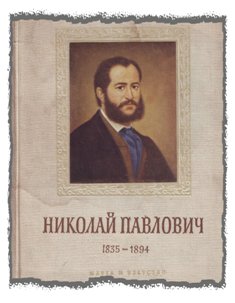
NIKOLAI PAVLOVICH ~ AN ALMANAC
Author: Nikolai Pavovich

There are several things at least that necessitate a biography on Nikolai Pavlovich /1835-1894/. The fact that he is the undisputable beacon of early artistic revival in Bulgaria has been documented in numerous sources. It is not by chance that the first National Art Academy in the country /1896/ has been named after this distinguished painter. Historians of art in post-liberation Bulgaria never hesitate to praise the spirit of that man, who played a role in esthetics and the same as his mentor Dr. Petar Beron in sciences.
An extensive epitaph as the book at hand — i.e., written by his grandson with the same name Nikolai Pavlovich, Jr. — comprises a bulk of material some 350 pages in total on big quarto. Such is the case, that we are not going to deal here with other strands of life other than the collaboration between the two colossus in bulgarian history P. Beron and titular N. Pavlovich on their work to print the earliest scientific atlases produced by bulgarians abroad. The story is syncretic in itself but do require links with other activities of the two masters, something we do believe to provide in the near future.
The work concerns the lithographic endeavor on "Atlas Cosmobiographique" and "Atlas Meteorologique" published in Paris, by Mallet-Bachelier printers, consecutively in years 1859 and 1860. Here are some details on these print-outs which are long time bibliographic rarity both for Bulgaria and France:
"Atlas Cosmobiographique" — viz., consists of a flip jacket (explication du frontispice) with 11 large tablets (planches). Contents of the atlas comprise, adapted on the material found in the book and not de vizu, a following scheme
1) Generation of two types of electricity based on heat and water;
2) Eruptions on the sun and solar steins with effects on the planets of the solar system;
3) Distribution of "epicratio du Arhaget" /i.e., unknown terminology used by Beron to define some kind of primeval matter/ among the stars;
4) Distribution of satellites on "epicratio du Arhaget" in the form of ring constelation;
5) Full planetary sky chart;
6) Distances between sky bolides with calculations on measurement;
7) Optical concavity of the satellites, change in their visionary colors, etc;
8) Transformation of the elements in the pagosphere /i.e., unknown terminology used by Beron to define an ice element contained in the air, plant and mineral matter, delusional water and other artifacts/;
9) Compilation of litho-pyramids with special reference on the surface of Jupiter;
10) On the consistency of Earth crest;
11) Continents and water basins before and after the deluge on the Earth.
"Atlas Meteorologique" — viz., consists of a flip jacket (explication du frontispice) with 11 large tablets (planches). Contents of the atlas comprise, adapted on the material found in the book and not de vizu, a following scheme
I. Atmospherologie
1) Origins of earth, winds and fires;
2) Hurricanes, clouds, rains, snow, etc;
3) Formation of hail (glacial snowflakes);
4) Winds and storms and their air-pressure phenomenon like thunder, lightning and others;
II. Climatologie
5) Distribution of rainfalls during the year with special reference point in July;
6) Same thing with special reference in January
7) Delineation and border of glaciers, moraines and other natural crevasses;
III. Earth Magnetism
8) Temperature declinations on the surface of the Earth;
9) Electrical anomalies due to magnetic intensity;
10) Role of ferrous ore on magnetism of the Earth;
IV. Hydrology
11) Underground waters, surface rivers, lakes, artesian wells, artificial irrigation, etc.
Pictures 1 & 2: Sample illustrations on the text.
|
(i). Tablet from "Atlas Cosmobiographique par Pierre Beron, Mallet-Bachelier, 1859".
|
|
(ii). Tablet from "Atlas Meteorologique par Pierre Beron, Mallet-Bachelier, 1860".
|
Copyright © 2008 by the author.